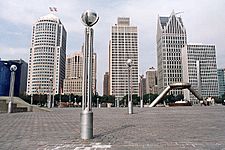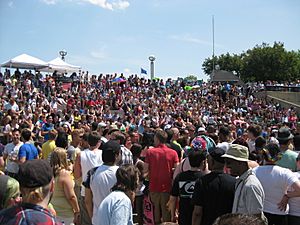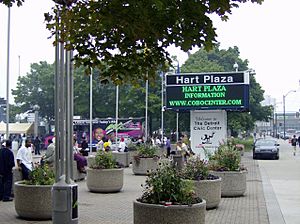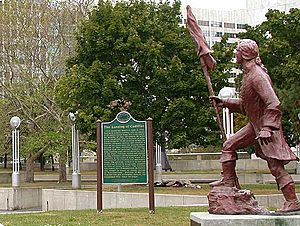Philip A. Hart Plaza facts for kids
Quick facts for kids Philip A. Hart Plaza |
|
|---|---|

The Detroit skyline from Hart Plaza
|
|
| Type | Municipal (City of Detroit) |
| Location | Detroit |
| Area | 14-acre (5.7 ha) |
| Created | 1975 |
| Operated by | City of Detroit |
| Open | All year |
| Status | Open |
Philip A. Hart Plaza is a cool city park in downtown Detroit, right along the Detroit River. It's a special place because it's believed to be where Antoine de la Mothe Cadillac first landed in 1701. He was the person who founded the settlement that later became Detroit.
This park is about 14-acre (5.7 ha) big. It's named after Philip Hart, who was a U.S. Senator. The plaza first opened in 1975 and can hold about 40,000 people. In the middle of the plaza, you'll find the amazing Horace E. Dodge and Son Memorial Fountain. It was designed by a famous artist named Isamu Noguchi in 1978.
Contents
Exploring the History of Hart Plaza
The spot where Hart Plaza is today is very important. It's thought to be the exact place where Antoine de la Mothe Cadillac arrived in 1701. For a long time, this waterfront area was the main way Detroit connected with the outside world. This was before trains and telegraphs were invented.
By the mid-1800s, this area was full of docks and warehouses. It was a busy industrial part of Detroit's waterfront.
Plans for a Waterfront Park
In 1890, Hazen S. Pingree, who was Detroit's mayor, thought this location would be perfect for a city center by the water. But his idea didn't happen at that time.
Later, in 1924, a famous architect named Eliel Saarinen was asked to create a design for a civic center on the waterfront. However, World War II put a stop to these plans. It wasn't until the late 1940s that work finally began. The first buildings to go up were a veteran's hall, an auditorium, and the city-county building.
Building the Plaza
When it was time to create what is now Hart Plaza, the design changed from Saarinen's original idea. He had imagined a big grassy area. Instead, they decided to build the concrete plaza we see today. It includes several built-in areas for concerts and, of course, the Dodge Fountain. The final design was created by the company SmithGroupJJR, with help from Isamu Noguchi.
The plaza officially opened in 1975. In 1976, it was named after Philip Hart, who was a U.S. Senator. The park was fully finished in 1979.
Special Memorials and Art
On July 24, 2001, which was Detroit's 300th birthday, a statue was revealed. It shows Antoine Laumet de La Mothe, sieur de Cadillac arriving in 1701.
On October 20, 2001, the Gateway to Freedom International Memorial to the Underground Railroad opened. This special monument remembers Detroit's important role in the Underground Railroad. It was sculpted by Edward Dwight.
Another artwork, called Transcending, was dedicated on August 30, 2003. It's a large arch sculpture that celebrates Michigan's labor history. You can find it near the entrance to Hart Plaza, close to Woodward Avenue and Jefferson Avenue.
In 2006, the Detroit/Wayne County Port Authority added a dock and passenger terminal for cruise ships. This allows big cruise ships like the MS Hamburg to visit.
Exciting Events at Hart Plaza
Thousands of people from the Midwest and Canada gather at Hart Plaza during the summer. They come for celebrations, concerts, and festivals. These events usually happen from May through September.
Some of the cool events held at Hart Plaza include:
- African World Festival
- Arab and Chaldean Festival
- Detroit China Festival
- Detroit Electronic Music Festival (Movement)
- Windsor–Detroit International Freedom Festival
- Detroit International Jazz Festival
- Detroit Paradise Valley Music Festival
- March for Babies
- Mega March for Animals
- Motor City Pride
- Rib's R-n-B Jazz Fest
- Rock n Roll Festival
What's Around Hart Plaza?
Hart Plaza is surrounded by many important places in Downtown Detroit. It's just a few blocks from the GM Renaissance Center (RenCen), and the TCF Center. In recent years, Hart Plaza has become a key part of the Detroit International Riverfront.
From Hart Plaza, visitors can look across the river and see Windsor, Ontario's riverfront. You can also see Belle Isle State Park.
Layout of the Plaza
The park is 8 acres in size. It's bordered by the Detroit River to the south and East Jefferson Avenue to the north. The plaza has two levels. The upper level is at the same height as Jefferson Avenue. It's made of cement and covered with a type of granite and concrete. This upper level hangs over the lower level, which is at the height of Atwater Street. The plaza was designed by Detroit architects Smith, Hinchman & Grylls with advice from Japanese American architect Isamu Noguchi.
The main entrance to the plaza is at the end of Woodward Avenue. Near the entrance, you'll see the Pylon. This is a tall, stainless steel sculpture designed by Isamu Noguchi. To the west of the entrance is the Michigan Labor Legacy Landmark. Its main feature is a 63-foot tall steel arch sculpture called Transcending.
In the center of the plaza is the Horace E. Dodge and Son Memorial Fountain, also designed by Isamu Noguchi. The lower level of Hart Plaza has an open-air amphitheater for shows. It also has dressing rooms, places to prepare food, public restrooms, and offices. There's even a Detroit Police Department post there.
Memorials and Sculptures in the Plaza
Antoine de la Mothe Cadillac Statue
This sculpture shows Antoine Laumet de La Mothe, sieur de Cadillac, the founder of Detroit. It captures the moment he arrived at this spot in 1701. The statue was a gift to Detroit from a French-American business group. It was revealed on July 24, 2001, Detroit's 300th birthday. The bronze statue was designed by William Kieffer and Ann Feeley.
Gateway to Freedom International Memorial to the Underground Railroad
This memorial is located on the riverfront of Hart Plaza. It honors Detroit's important role in the Underground Railroad. This was a secret network that helped enslaved people find freedom. The sculpture was created by Edward Dwight and dedicated on October 20, 2001. A similar monument, the Tower of Freedom, is located across the river in Windsor, Ontario.
Detroit was a major stop on the Underground Railroad, often called "Midnight." At first, Michigan was a safe place for freedom seekers. But after slavery was ended in Canada in 1834, Canada became an even safer place. When the Fugitive Slave Act was passed in 1850, many people who had escaped slavery in Detroit crossed the river to Canada to stay free. Some returned after slavery was abolished in 1863.
This memorial has two tall pillars. Between them is a sculpture showing six people who escaped slavery. They are ready to get on a boat to cross to Canada. The man pointing from Detroit to Windsor is George DeBaptist. He was a Detroit resident who helped many enslaved people reach freedom. The monument's plaque also mentions several Detroit groups that helped with the Underground Railroad.
In October 2011, the monument was cleaned and repaired for its ten-year anniversary. Many people and groups celebrated this important milestone.
Horace E. Dodge and Son Memorial Fountain
The Horace E. Dodge and Son Memorial Fountain is in the center of Hart Plaza. Isamu Noguchi designed it in 1978, and it was built in 1981. Anna Thompson Dodge gave $1 million to Detroit to build this fountain. It honors her late husband and son.
The fountain is made of stainless steel. It has two legs that hold up a ring, reaching 30 feet high above a round, black granite pool. The fountain has 300 water jets and 300 lights. It can create different water patterns and light shows, which can even change based on the temperature.
The Dodge fountain was not working for several months in 2013. This was because of damage done to the plaza, with a lot of the damage happening to the fountain itself.
Pylon
The Pylon is a tall, stainless steel sculpture designed by Isamu Noguchi. It stands near the entrance to Hart Plaza. The sculpture is 120 feet (37 m) tall. It looks like a double helix, similar to the shape of DNA. It seems to twist a quarter turn from bottom to top.
The name "Pylon" often refers to large gateway structures from ancient Egypt. These structures were built in important places. The word now describes any tall tower, like those that hold up power lines.
This sculpture was built in 1981. It was designed to go along with the Horace E. Dodge and Son Memorial Fountain. The cost of the sculpture was paid for by funds given to the City of Detroit.
Transcending
Transcending is a large arch sculpture. It's also known as the Michigan Labor Legacy Landmark. You can find it west of the entrance to Hart Plaza, near Woodward Avenue and Jefferson Avenue. It was dedicated on August 30, 2003.
In 2000, a group called the Michigan Labor History Society wanted to create a monument. It would celebrate Michigan's contributions to the labor movement. Money was raised from groups like the United Automobile Workers and AFL–CIO. Many artists entered a competition to design the sculpture.
The winning design was "Transcending," created by David Barr and Sergio de Guisti. It has two steel arches that reach 63 feet (19 m) into the sky. They weigh 30 short tons (27 t). David Barr saw them as a stylish gear coming out of the ground. The arches are not joined, which some people think means the work of the American labor movement is not yet finished. However, at night, a light shines from one arch to the other. The artists said this light represents the energy of workers.
At the base of the sculpture are fourteen large Vermont granite boulders, each 6 feet (1.8 m) tall. These boulders have carvings by Sergio de Guisti. They show the sacrifices and achievements of American workers. There are also plaques that list accomplishments of the American labor movement. These include stopping child labor, creating free public schools, and providing pensions and health care from employers.
The monument stands close to where Martin Luther King Jr. first gave his famous "I Have a Dream" speech on June 20, 1963. This speech was later repeated at the Lincoln Memorial. One of Dr. King's famous sayings, "The arc of history bends toward justice," is carved into the sculpture.
A few lines from a poem by Melba Boyd, "We Want Our City Back," are also written on the sculpture.
See also
 In Spanish: Plaza Philip A. Hart para niños
In Spanish: Plaza Philip A. Hart para niños





